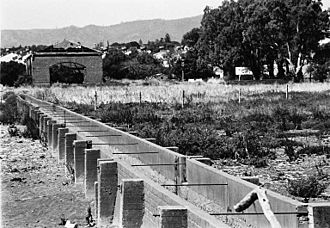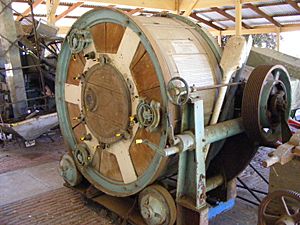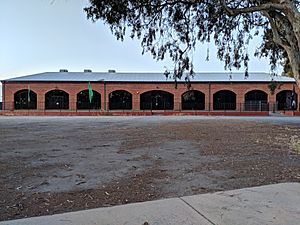Islington Sewage Farm facts for kids
Quick facts for kids Islington Sewage Farm |
|
|---|---|

Islington straining shed c. 1890 (facing east)
|
|
| Alternative names | Tam O'Shanter Sewage Farm |
| General information | |
| Status | Partly demolished with remainder heritage listed |
| Location | Tam O'Shanter, South Australia |
| Town or city | Adelaide |
| Coordinates | 34°51′36″S 138°34′12″E / 34.860°S 138.570°E |
| Groundbreaking | 1879 |
| Opened | 1881 |
| Closed | 1966 |
The Islington Sewage Farm (also called the Tam O'Shanter Sewage Farm) was a special place in South Australia. It was a facility that cleaned up dirty water from homes and businesses. This important farm was located in an area now known as Regency Park. It worked for many years, from 1881 until 1966. Some people believe it was Australia's very first system for treating water waste.
Contents
History of the Sewage Farm
Building the Farm
In 1879, the City of Adelaide bought land to build the Islington Sewage Farm. This land is now part of Regency Park. The farm started working in 1881. It was built to help manage the city's waste water.
Farm Operations and Closure
By 1948, a concrete channel was added to help move water to the North Arm Creek. After World War II, many more people moved to the area. This meant the sewage farm became too busy. It could not clean all the dirty water. So, some untreated water had to go straight into the North Arm Creek.
Plans for a new, bigger water treatment plant started in 1960. In 1966, the job of cleaning water moved to the Bolivar Waste Water Treatment Plant. This new plant is about 6 km (3.7 mi) north of the old farm. After the new plant opened, the Islington Sewage Farm closed down. The land was then used to create a new industrial area called Regency Park.
Preserving History
From 1975 to 1981, parts of the old sewage farm land were sold. But some important parts were saved. One part was Sunnybrae Farm, which was the home of the sewage farm manager. This 4.5-acre (1.8 ha) area was saved in 1981. It was given to the City of Enfield to become a Historic Conservation and Recreation Centre. History fans worked with the council to fix up the old farm buildings. Today, Sunnybrae Farm is a place for events and has a museum.
Another part that was saved was the straining shed. This 3,500-square-metre (38,000 sq ft) site is about 400 m (1,300 ft) southeast of Sunnybrae Farm.
Sunnybrae Farm Complex

The Sunnybrae Farm Complex is a historic site in Regency Park, South Australia. It is listed as a heritage site. The main house at Sunnybrae was once the official home for the sewage farm's manager.
What Was at Sunnybrae?
Besides the manager's house, the complex also had other buildings. These included the Dairymen's Quarters, a Cheese Room, Cellars, Stables, a Cow Shed, and a Smoke House. From 1882 to 1884, the farm was used for making dairy products like cheese. It also continued to be used for keeping animals and growing vegetables and fruits. These plants were watered using the treated sewage.
Sunnybrae Today
In 1990, the City of Enfield gave the Sunnybrae property to the Enfield & Districts Historical Society. They wanted to create a museum about local history. The museum officially opened in June 1995. In 2001, the society built the Sunnybrae Farm Federation Pavilion. They received a grant of $28,000 to help with this.
The historical society held open days and other public events from 2002 to 2008. In July 2012, the society closed down. The property then became privately owned. It is now known as Sunnybrae Estate and is used as a place for events and functions.
Islington Straining Shed
The straining shed was an important part of the old sewage farm. It was saved when the land was sold in the 1970s. The Islington Sewage Farm Straining Shed was made a state heritage-listed site in 1984.
Why the Straining Shed is Important
This building is important because it shows how waste was treated in the late 1800s. It was part of a big system to clean dirty water. The straining shed also shows how public buildings were designed back then. Even simple structures were built to look good and show civic pride. You can find the straining shed about 400 m (1,300 ft) southeast of Sunnybrae Farm, near Pedder Crescent. It can be seen from Regency Road.



